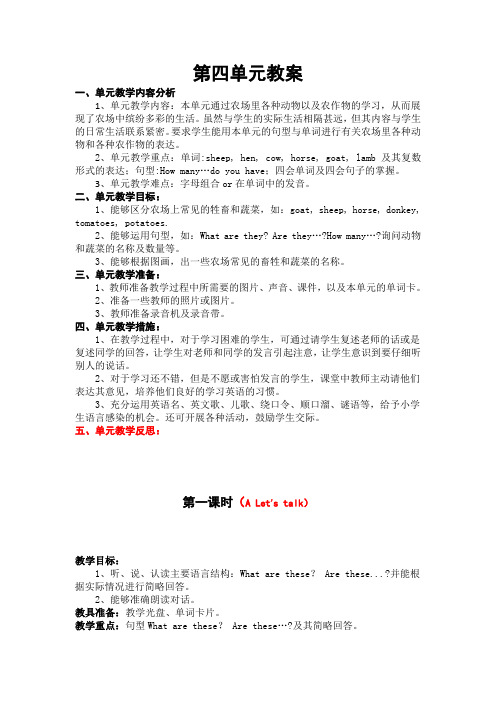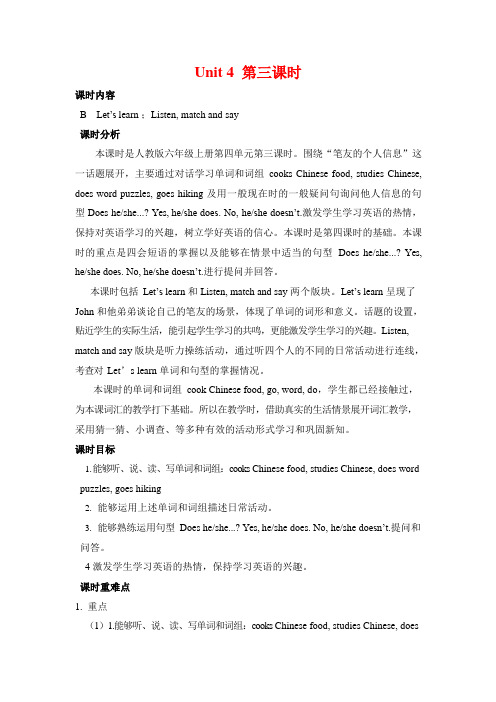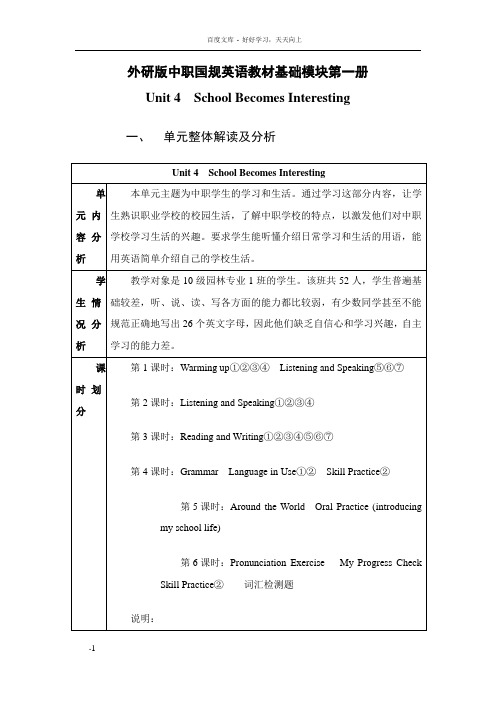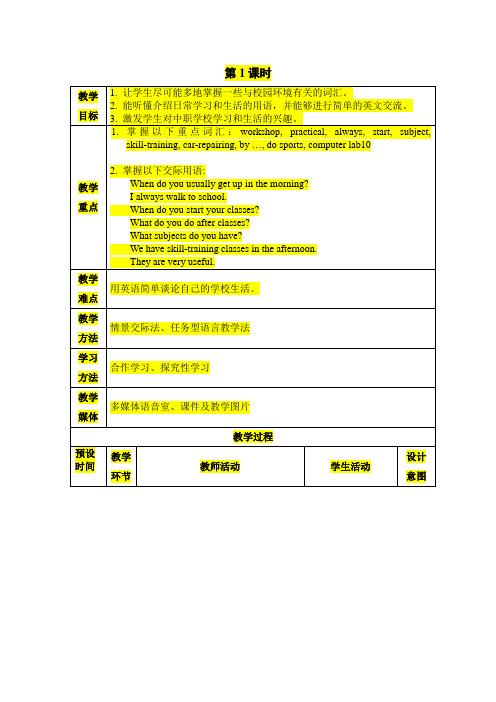Unit4SchoolBecomesInteresting第3课时教案
- 格式:doc
- 大小:37.00 KB
- 文档页数:5

第四单元教案一、单元教学内容分析1、单元教学内容:本单元通过农场里各种动物以及农作物的学习,从而展现了农场中缤纷多彩的生活。
虽然与学生的实际生活相隔甚远,但其内容与学生的日常生活联系紧密。
要求学生能用本单元的句型与单词进行有关农场里各种动物和各种农作物的表达。
2、单元教学重点:单词:sheep, hen, cow, horse, goat, lamb及其复数形式的表达;句型:How many…do you have;四会单词及四会句子的掌握。
3、单元教学难点:字母组合or在单词中的发音。
二、单元教学目标:1、能够区分农场上常见的牲畜和蔬菜,如:goat, sheep, horse, donkey, tomatoes, potatoes.2、能够运用句型,如:What are they? Are they…?How many…?询问动物和蔬菜的名称及数量等。
3、能够根据图画,出一些农场常见的畜牲和蔬菜的名称。
三、单元教学准备:1、教师准备教学过程中所需要的图片、声音、课件,以及本单元的单词卡。
2、准备一些教师的照片或图片。
3、教师准备录音机及录音带。
四、单元教学措施:1、在教学过程中,对于学习困难的学生,可通过请学生复述老师的话或是复述同学的回答,让学生对老师和同学的发言引起注意,让学生意识到要仔细听别人的说话。
2、对于学习还不错,但是不愿或害怕发言的学生,课堂中教师主动请他们表达其意见,培养他们良好的学习英语的习惯。
3、充分运用英语名、英文歌、儿歌、绕口令、顺口溜、谜语等,给予小学生语言感染的机会。
还可开展各种活动,鼓励学生交际。
五、单元教学反思:第一课时(A Let’s talk)教学目标:1、听、说、认读主要语言结构:What are these? Are these...?并能根据实际情况进行简略回答。
2、能够准确朗读对话。
教具准备:教学光盘、单词卡片。
教学重点:句型What are these?Are these…?及其简略回答。

Unit 4 第三课时课时内容B Let’s learn ;Listen, match and say课时分析本课时是人教版六年级上册第四单元第三课时。
围绕“笔友的个人信息”这一话题展开,主要通过对话学习单词和词组cooks Chinese food, studies Chinese, does word puzzles, goes hiking 及用一般现在时的一般疑问句询问他人信息的句型Does he/she...? Yes, he/she does. No, he/she doesn’t.激发学生学习英语的热情,保持对英语学习的兴趣,树立学好英语的信心。
本课时是第四课时的基础。
本课时的重点是四会短语的掌握以及能够在情景中适当的句型Does he/she...? Yes, he/she does. No, he/she doesn’t.进行提问并回答。
本课时包括Let’s learn 和Listen, match and say 两个版块。
Let’s learn 呈现了John 和他弟弟谈论自己的笔友的场景,体现了单词的词形和意义。
话题的设置,贴近学生的实际生活,能引起学生学习的共鸣,更能激发学生学习的兴趣。
Listen, match and say 版块是听力操练活动,通过听四个人的不同的日常活动进行连线,考查对Let’s learn 单词和句型的掌握情况。
本课时的单词和词组cook Chinese food, go, word, do,学生都已经接触过,为本课词汇的教学打下基础。
所以在教学时,借助真实的生活情景展开词汇教学,采用猜一猜、小调查、等多种有效的活动形式学习和巩固新知。
课时目标1.能够听、说、读、写单词和词组:cooks Chinese food, studies Chinese, does word puzzles, goes hiking2.能够运用上述单词和词组描述日常活动。


教师学科教案[ 20 – 20 学年度第__学期]任教学科:_____________任教年级:_____________任教老师:_____________xx市实验学校Unit4 第3课时参考教案【内容来源】人教PEP 四年级下册Unit4【主题】At the farm【课时】第3课时:B. Let’s learn B. Let’s play一、教学目标1. 学习词汇:horse, cow, sheep, hen。
2. 学习句型:These are...3. 能询问农场里的动物并作出回答。
4. 能根据描述画出农场里的动物和蔬菜。
二、教学重难点重点1. 能听、说表示农场里动物的单词horse, cow, sheep, hen。
2. 能用句型These are ...介绍农场里的动物。
难点单词sleep的单复数相同。
三、教学准备1. 教师准备多媒体课件、教学音频、词卡。
2. 学生准备画笔和画纸。
四、教学过程Step 1: Warm-up1. 课堂口语练习。
T: Good morning, boys and girls.Ss: Good morning, Mr/Miss...T: How are you today?Ss: Very well, thanks.T: Nice to meet you.Ss: Nice to meet you, too.T: It’s time for our class. Let’s begin.2. 教师请两三组学生上讲台表演A Let’s talk部分的对话。
Step 2: Preview教师说:I like vegetables. Do you like vegetables? What vegetables do youknow?学生说出自己知道的蔬菜的名称。
然后教师拿出蔬菜图片,问:Are these ... 学生根据图片回答Yes, they are.或No, they aren’t.Step 3: Presentation1. B. Let’s learn.(1) 教授新词T: Children, do you know a farm? Miss Ding has a farm, and there are many animals on it. Let’s have a look. (播放卡通动画片。


第1课时2’导入 1. 展示一张本校学生在车间上实训课的图片,问学生下列问题:a. Are the students in the classroom?b. Where are they?c. What are they doing?d. Are they happy?2. 学生回答完问题后,教师对学生说:Today, we begin to learn Unit 4.After this class, you will be able totalk about your school life.课件投影,显示下列内容:Unit 4 School Becomes InterestingYou will be able to talk about yourschool life. 学生看视频回答左边的四个问题。
Answers:1. No, they aren’t.2.They are in the greenhouse.3. They are learningto grow plants.或They are learning practical skills.4. …引入本单元的话题,激发学生的专业兴趣。
18’提高听力引导学生学习两则对话:Dialogue One (P48③④)1. 引导学生根据单词、关键句及书上的图片预测对话内容。
(Thedialogue is about school life.)2.(课件投影)给学生半分钟时间读题,之后播放录音两遍,要求学生完成下面的选择填空练习。
(视情况可多放一遍录音)①When does Claire usually getup in the morning?A.6:30B. 7:00C. 7:30②When does she have breakfast?A.6:30B. 7:00C. 7:30③How does she go to school?A. By bikeB. On footC. By bus④When does she start her class?A. 8:00B.8:20C. 8:30⑤What does she do after classes?A. Does sportsB. Listens to musicC. Goes shoppingDialogue Two (P50⑤)1. 引导学生朗读对话,试填所缺单词。
英语课程教案课题School Becomes Interesting教学时数 4 授课教师田微授课班级13电厂、热动、测量、水工班教材《英语》(基础模块)第一册,外研社教学目标一、语言知识目标1.掌握与一般现在时连用的频度副词的用法。
2.掌握一般现在时的否定句和一般疑问句的变换方法。
二、语言技能目标1.能够听懂介绍日常学习和生活的用语。
2.能根据本单元的课文及对话,针对所提供的信息谈论自己的学校生活。
3. 能够根据所给信息进行词组造句等书面表达。
4. 学习介绍自己的学习和生活。
三、情感与策略通过学习本单元,熟悉职业学校的校园生活,养成良好的学习习惯。
教学重点能够听懂介绍日常学习和生活的用语教学难点能够用英文谈论自己的学校生活教学准备投影仪,笔记本,PPT课件教法学法讲述法:通过教师给学生讲述重点难点,帮助学生掌握课文。
演示法:通过使用PPT课件,使学生在生动的环境下学习重点知识点,提高他们学习的兴趣。
总体思路本单元以介绍中职学生的日常学习、生活为主,通过学习这部分内容,让学生更加了解中职学校的特点。
重点教学环节设计个性化教学一、复习:通过上一单元的学习,我们学习了如何谈天气。
在这里复习下重点知识。
①write the words in English.多云的暴风雨刮风的晴朗的在北方②reading:.Read the text of reading and writing二、新课导入童鞋们来到职业学校学习,学习和生活上都会与以前不同,那么这里的生活是什么样子的呢?Warming up首先用PPT给出书上的图片及单词,然后让学生进行连线。
Then let’s study the words. 教学光盘及下载的网络知识可以活跃课堂气氛,亦可以增加学习效果。
First, answer the questions: Then study the words ③Do exerciseListening and SpeakingTo learn the new words.then listen to the dialogue and repeat.首先,让学生先自己听录音,然后将难点在书上标记,这样便于听讲,之后,根据录音跟读对话。
人教新起点三年级上册英语Unit4 Revision第三课时课题Unit4 Revision Lesson 21 课时1课时教学内容Words: the words of foods and body parts.Sentences:His foot hurts.教学目标1. Can pronounce the new words well andcorrectly and can use them freely.2. Can make the sentences by using somewords they know.3. Show the dialogue correctly andfreely.教学重点To grasp the new words, make some sentences and dialogues. 板书设计Unit 4 Lesson 21What's the matter with Bill?His foot hurts.Do you eat….?Please eat lots of fruits and vegetables.Have them every day.教学难点Do you eat... ? No, Idon't.“Please eat lots of fruitsand vegetables.Have them every dayfor lunch.教学准备pictures word-cardstape-recorder教学过程二次备课I. Organization1. T and students sing a song.2. Free talk : What do you eat? Do you eat…?II.Presentation1. Role play: T let some Ss to act ,other Ss guess which part are they hurt.S1: What's the matter with …?S2: His/her …hurts.2. Learn the new dialogues:What's the matter?I feel bad.Do you eat apples, carrots, potatoes and tomatoes?No, I don't.I eat meat.I like sausages, meatballs and beef.Please eat lots of fruits and vegetables.Have them every day for lunch.1)listen to the record2)Ss read the dialogue3. T and Ss look at the picture and Ss say what food they’ve seen in PartC.Listen to the tape and follow.4. Ss look and color the letters in Part D.家庭作业1. Listen to the tape and read the text.2. Write and recite the new words and PartC in the lesson.课后回顾。